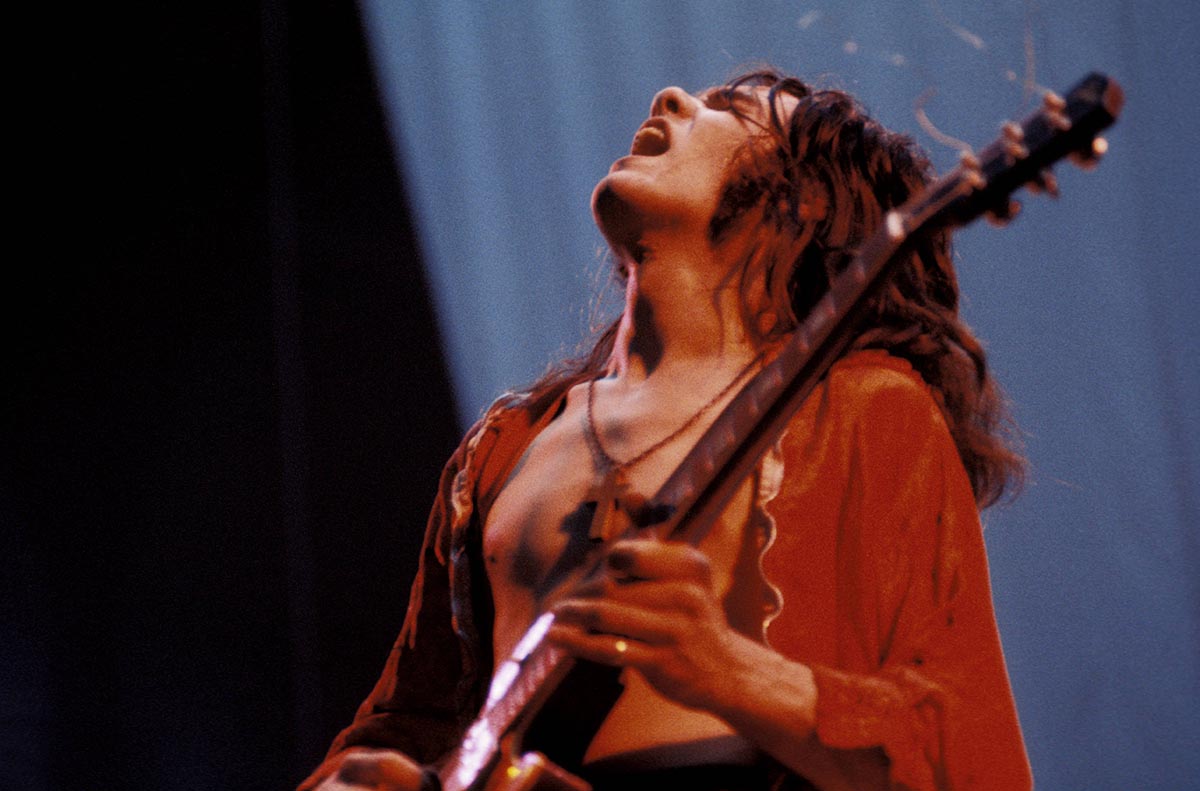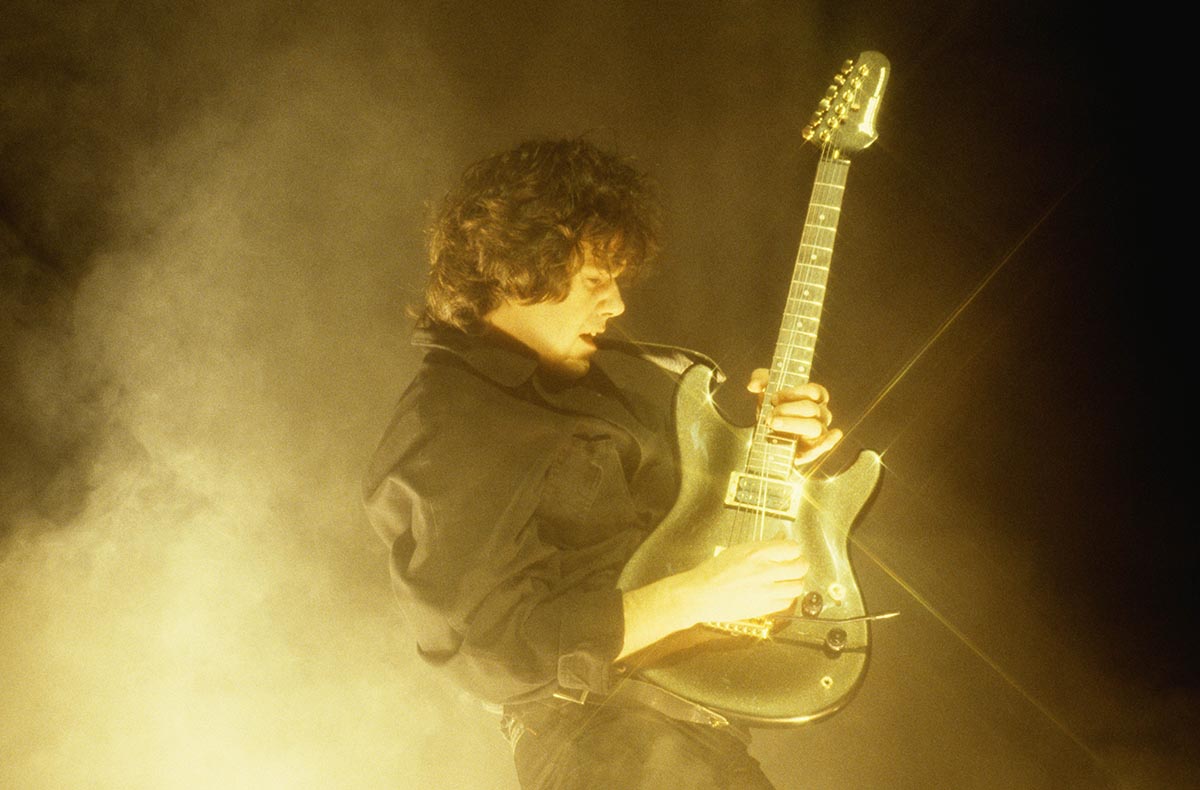How Gary Moore's propulsive playing and fiery tone changed the course of blues guitar
The life and times of the Irish guitar hero who became a hugely influential figure in the world of blues and rock, with Thin Lizzy and beyond

If you play high-gain, uptempo blues these days, chances are the late, great Gary Moore is one of your go-to guys. That’s certainly true of Kris Barras, a leading name among the modern generation of blues rock guitarists.
“Gary loved traditional blues,” Kris tells Total Guitar, “but his blues style was very much rock-influenced, and that’s what drew me to him. The blues police are always there – to them if you weren’t around in the 1960s, don’t just play 12-bar stuff and turn your gain up above four, then you’re not real blues! But for me blues is about passion and emotion, and Gary Moore had that in spades.
“It was the power and passion in his notes. His style was aggressive – with his hammer-ons and pull-offs, his trills and vibrato – the attack he had. He’d be soft and melodic then give it a big powerful burst, and I love those dynamics. I don’t like things being moderate!”
Moderation was something that Moore, who died in 2011 aged just 58, was rarely accused of, but as shown on his new, posthumous eight-track release How Blue Can You Get, his fretboard talent was undiminished to the end.
The album’s title track, a hit for BB King back in 1942, is a 12-bar blues in C that drips with bluesy feel; Moore’s cultured facility for King’s Chicago-style licks, married to his thicker, hard rock tone and fast hammered/pulled pentatonic licks makes for a thrilling listen.
Opener I’m Tore Down was popularised by the imposing blues genius Freddie King, and in Moore’s hands it’s a roaring blues in D, one he would sometimes belt out at gigs such as Montreux Festival back in ’99. His facility for slide guitar is clear from his excoriating take on Done Somebody Wrong, an Elmore James song famously tackled by the Allman Brothers on their classic live LP At Fillmore East.
And among the ballads and forward-thinking rockers, perhaps the most historically relevant song present is his cover of Memphis Slim’s Steppin’ Out. This song was given new life on the 1966 album Blues Breakers With Eric Clapton, aka ‘The Beano Album’. It was the sole record Clapton made with John Mayall’s star-making group, and it changed the young Gary Moore’s life.
All the latest guitar news, interviews, lessons, reviews, deals and more, direct to your inbox!

In 1966, Gary was just 14, already a self-professed ‘blues snob’, and playing guitar in local bands in his hometown, Belfast. He would regularly share a stage – and guitars and amps – with another upcoming player, Rory Gallagher. Clapton’s new sound hit Moore hard.
“I’d been playing for five years when that came out,” he told this writer in 2004, “and I heard Eric using that Les Paul/Marshall combination. He kind of invented rock guitar as we know it – playing the blues with that edgy, aggressive tone. Then I heard Jeff Beck and Peter Green, and that’s where it all came from for me.”
He met gifted yet troubled guitarist Green two years later in Dublin, when Moore’s new band Skid Row supported Green’s Fleetwood Mac.
“Peter was such a huge influence on me,” Gary said. “I’d seen him play at [Belfast rhythm ’n’ blues venue] Club Rado, he was using this amazing Les Paul that I went on to own, he plugged into a rented Selmer amplifier and the whole place was vibrating with his sound. The tone was so beautiful. Peter discovered me in Skid Row in Dublin when I was 16, and he persuaded his manager to bring us to England.”
That 1959 Les Paul, affectionately nicknamed ‘Greeny’, is now owned by another Moore super-fan, Metallica’s Kirk Hammett. It’s the instrument heard on Fleetwood Mac hits such as Need Your Love So Bad and Man Of The World, its uncharacteristically single-coil sound down to the pickups being wired out of phase.
Moore called it ‘a battle axe to play’, but would use it throughout his career, notably on Blues For Greeny, his 1995 album dedicated to his hero. It’s also on the new collection, How Blue Can You Get – its unique tone is clear and present on the self-penned closing track, Living With The Blues.
After Skid Row, Moore’s career passed through various phases, and slowly but surely his incredible proficiency on the electric guitar saw him drift away from his roots in the British Blues Explosion. Between 1975 and 1978 he played jazz-rock in the group Colosseum II. More famously, his sporadic, turbulent membership of Thin Lizzy proved his rock chops to millions worldwide.
The classic Lizzy song Waiting For An Alibi from the 1979 album Black Rose was an example of his formidable shred-rock style as he shared dazzling harmony lines with co-guitarist Scott Gorham. But, tellingly, Gary would share a room with Lizzy drummer Brian Downey on tour, and they would indulge their mutual love for the blues, playing cassettes featuring Mayall, Albert and BB King, and of course Peter Green.
As a solo artist, Moore’s early albums showed the sheer conviction of his playing, and in 1978 the album Back On The Streets gave him his signature hit. The UK Top 10 ballad Parisienne Walkways was sung by Lizzy’s Phil Lynott, rested on a gentle 6/8 rhythm, with Moore’s beautifully expressed Les Paul-voiced lead hook wrung from the A Harmonic Minor scale, over the song’s jazz standard-style chord changes - Am/Dm7/G11/Cmaj7/Fmaj7/Bdim/E.
Moore often strung his guitars with .010-.052s, usually Dean Markleys, and always used extra-heavy picks. All the better to play the hard rock/heavy metal that won him a large loyal following (Kris Barras’s dad among them) in the 80s. On the albums Corridors Of Power (1982) and Victims Of The Future (1983), the riffs got heavier, the guitars got pushed through more effects, and his trusty Tube Screamer got cranked way up.
The solos got faster (check out the E-minor picking/legato workout Speak For Yourself, on 1989’s After The War), and Moore had more hit singles with power ballads (Empty Rooms) and rock anthems (Out In The Fields, with Lynott). But as Moore’s guitar rack filled with a heavy metal arsenal of Hamers, Charvels and Ibanezes, he grew tired of the overblown trappings of '80s rock. By the After The War tour he was exhausted creatively, disconnected from what had got him into music in the first place.
He could usually be found in his dressing room before a sold-out show, picking away at the blues, maybe on his trusty 1961 salmon-pink Strat, or even Greeny itself. When his bassist Bob Daisley noticed this he suggested he make a blues record next, and Moore laughed – he had too much to lose to change tack.
But despite some misgivings the idea stuck, and the next record he made was the game-changer. For 1990’s Still Got The Blues, he went back to the records he adored. Among the no-brainers was Otis Rush’s All Your Love, a crowning moment from that Clapton/Bluesbreakers ‘Beano Album’.

Oh Pretty Woman was a tune popularised by blues great Albert King on his 1967 LP Born Under A Bad Sign. King guested on the track, and with his Flying V somewhat crushed by Moore’s huge Les Paul sound, King offered his host a valuable piece of wisdom during the recording: ‘play every other lick’. This chimed with Moore, who came to once again appreciate the value of space and anticipation, of tension and release.
Albert Collins, ‘The Master Of The Telecaster’, joined Gary for a duel on the 1955 Johnny Guitar Watson tune I’m Tired, with Moore opting for his ’61 Strat. To get that thinner guitar’s output nearer that of his Les Pauls, he would often drive it through a Boss DS-1 pedal.
He used that guitar again on the upbeat Texas Strut, a self-penned tune that name-checks two of that state’s great blues players, Billy Gibbons and Stevie Ray Vaughan, but pulled out his ’68 Strat – tuned to open-A – for the slide guitar of album opener Moving On.
Greeny itself was uncased for the classic Fleetwood Mac tune Stop Messin’ Around, and Moore’s Beatle friend George Harrison even contributed a new song, That Kind Of Woman, but the title track really told the tale. With its big, clear Les Paul lead motif in A minor, 6/8 metre and familiar chord progression (Dm7/G11/Cmaj7/Fmaj7/Bdim/E/Am), Still Got The Blues was a close musical relative of Parisienne Walkways. When it came together in just one take, Gary knew he was back on the right path.
“It was one of those days when everything went right for me,” he said. “I’d bought another 1959 Les Paul, I’d had it for a few years by this point but had never really played it. We were trying out the room [Sarm Studios]. I had the sound in my head – I took that guitar and plugged into in this Marshall JTM45 reissue amp [set clean; mids up], and they had this new pedal at the time called The Guv’nor [mids and gain both cranked], which was the first Marshall overdrive of that generation.
“We’d rehearsed the song, obviously, but we did it and recorded it in one take. That guitar, the solo and everything, just came out like that, unbelievably. I’ll never forget hearing that guitar in the headphone and thinking, ‘Let’s just go for it, show ‘em what you’re made of.’ We thought we were just doing demos, which helped, because there was no pressure on you, but that version grew on us and we kept it. The same day we did the Albert King track. It was a great day.”

Nicknamed ‘Stripe’, that ’59 Les Paul Standard was all stock except for new Grover tuners and a re-fret (Moore favoured jumbo frets). And it promptly became Moore’s main instrument after the Still Got The Blues sessions. It was also used by Gibson as the model for Moore’s signature Les Paul, produced between 2000 and 2002.
Moore was fiercely proud of having his name on his own guitar’s headstock, and these would be his main live guitars for the rest of his life, which was redefined by the success of his new album. Still Got The Blues hit No. 13 in the UK album chart and was certified platinum there in 1994, going on to sell millions across the world.
While Moore did lose some of the more metal-minded members of his existing audience, his evolving status as a blues superstar made him accessible to legions of new fans, and other players noticed. Back in the metal world, Kirk Hammett was galvanised by Moore’s guitar tone to write the write riff for Metallica’s The Unforgiven, a song that appeared on the band’s self-titled 1991 album, a multi-million selling hit.
In the '90s, future blue-eyed boy of the blues Joe Bonamassa was a teenager, freshly dumped from his first band Bloodline, and in the early stages of a solo career. Looking across the Atlantic, he watched Moore’s renaissance with interest – clearly there was an audience in Europe for robust, gained-up blues.
In 2015, Bonamassa told Viennese TV channel Multaschag: “Whereas the US had Stevie Ray Vaughan, Europe had Gary Moore. He was this bull in a china shop playing blues songs on an old Les Paul through a couple of Marshalls – I’ll give you one guess where I got that playbook!“
As his success grew, first in Europe, then at home, Bonamassa would add Still Got The Blues’ slow and moody tune Midnight Blues to his setlist, by way of tribute. Ironically Moore later concurred with the critics (and the ever-vigilant blues police) who had considered that album too overblown and heavy to constitute a pure blues record.
Gary wrote great songs, his voice is often overlooked, and his effect on guitar playing will be felt for decades to come
Kris Barras
Although his subsequent catalogue was built on his winning fusion of blues and hard rock, he thought of ‘95’s Blues For Greeny as his first blues album proper, as he strapped on Green’s Les Paul, dialled down the distortion, and ‘played every other lick’, in honour of the bluesman he owed so much. Kris Barras was just 10 when Blues For Greeny came out.
“That album really opened a door for me,” he recalls. “It was some of Gary’s most traditional bluesy stuff. Through him I realised what the genre really was, and then I went back and discovered the big blues guys, like Albert Collins and BB King. The first CD I ever bought with my own money was Stevie Ray Vaughan’s Texas Flood.”
For Barras and others in the new generation of amped-up, high-gain blues rockers, Gary Moore’s name comes up regularly in interviews, and Barras for one is fine with it. “I’m not ashamed of his big influence! Gary wrote great songs, his voice is often overlooked, and his effect on guitar playing will be felt for decades to come. He was a generational talent.”
- How Blue Can You Get is out now via Provogue.
Grant Moon is the News Editor for Prog magazine and has been a contributor to the magazine since its launch in 2009. A music journalist for over 20 years, Grant writes regularly for titles including Classic Rock and Total Guitar, and his CV also includes stints as a radio producer/presenter and podcast host. His first book, Big Big Train - Between The Lines, is out now through Kingmaker Publishing.


